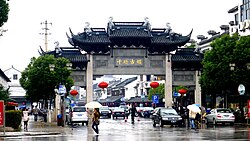Qiandeng
 From Wikipedia - Reading time: 6 min
From Wikipedia - Reading time: 6 min
Qiandeng
千灯镇 | |
|---|---|
 | |
| Coordinates: 31°16′12″N 121°00′00″E / 31.2700°N 120.9999°E | |
| Country | People's Republic of China |
| Province | Jiangsu |
| Prefecture-level city | Suzhou |
| County-level city | Kunshan |
| Time zone | UTC+8 (China Standard) |
Qiandeng (simplified Chinese: 千灯; traditional Chinese: 千燈; pinyin: Qiāndēng; lit. 'one thousand lamps') is a town in Kunshan, Suzhou, Jiangsu, China.[1] As of 2018[update], it has 12 residential communities and 16 villages under its administration.[2] It is located 15 kilometers south of Kunshan city and borders Qingpu District, Shanghai on its east side. Qiandeng has an area of 84km2 and a population of about 130,000 people.
Qiandeng has a rich cultural heritage. It was the native place of Gu Jian, the founder of Kunqu. It was also the birthplace of the famous Ming dynasty writer Gu Yanwu. Qiandeng is now a national historical and cultural town in China, as well as a national 4A grade scenic destination.
History
[edit]Qiandeng was called Qiandun (Chinese: 千墩; lit. 'one thousand pier') since the Ming dynasty. It was renamed Qiandun village in 1910, established as a township in 1950, and changed to its present name in 2003.
-
4A travel destination
-
Ancient slabstone lane
-
Peony pavilion
Gu Jian Museum
[edit]Gu Jian Museum commemorates Gu Jian (顧堅, fl. 14th century?), the founder of Kunqu. It is located at the west bank of Qiandeng river.
-
Gu Jian Museum
-
Gu Jian, founder of Kunqu
Former residence of Gu Yanwu
[edit]The former residence of Gu Yanwu was built by Gu Yanwu's grand father, it was destroyed by Japanese pirates, later rebuilt. It is a Ming Dynasty style building complex with formal sitting room, dining room, study and a garden. Gu Yanwu's grave is located at a quiet corner of the Gu Garden
-
Former residence of Gu Yanwu
-
Parlor Yi An Hall
-
study
-
Gu Garden
-
Grave of Gu Yanwu
Thousand Lamp Museum
[edit]A unique exhibition with the town's namesake is Qiandeng Guan(Thousand Lamp Museum), with more than one thousand lamps, dated as early as Neolithic Age to modern times, spanning more than five thousand years.
-
Thousand Lamp Museum
-
Qiandeng Museum Neolithic stone lamp
-
Han Dynasty Pottery lamp feathering a mother holding several babies
-
Tang Dynasty lamp from the Western Region
-
Yuan Dynasty lamp
-
Ming Dynasty bronze lamp
References
[edit]- ^ 2018年统计用区划代码和城乡划分代码:昆山市 (in Chinese). National Bureau of Statistics of the People's Republic of China. Retrieved 2019-02-26.
- ^ 2018年统计用区划代码和城乡划分代码:千灯镇 (in Chinese). National Bureau of Statistics of the People's Republic of China. Retrieved 2019-02-26.
 KSF
KSF
















